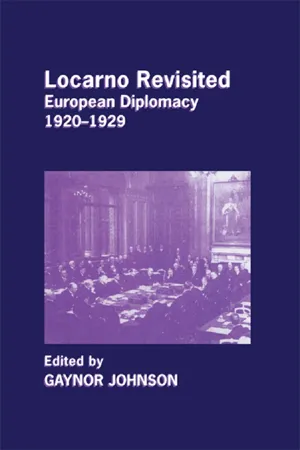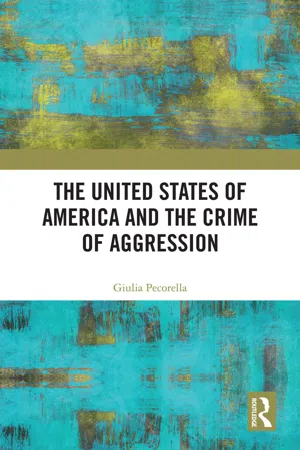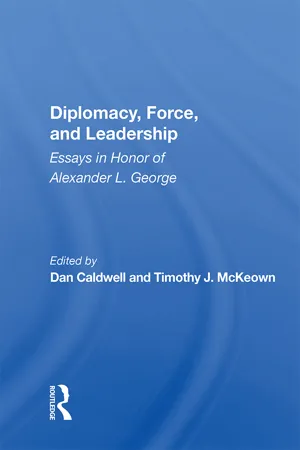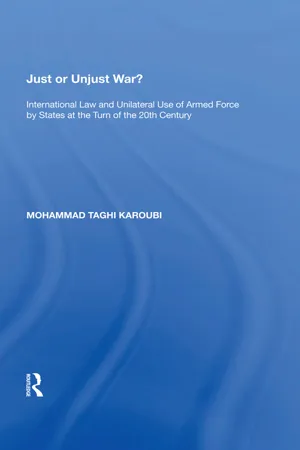History
Kellogg-Briand Pact
The Kellogg-Briand Pact, signed in 1928, was an international agreement between 62 countries to renounce war as a means of settling disputes. It was an attempt to prevent another world war and promote peace through diplomacy and arbitration. However, it ultimately failed to prevent the outbreak of World War II.
Written by Perlego with AI-assistance
Related key terms
4 Key excerpts on "Kellogg-Briand Pact"
- eBook - ePub
Locarno Revisited
European Diplomacy 1920-1929
- Gaynor Johnson, Gaynor Johnson(Authors)
- 2004(Publication Date)
- Routledge(Publisher)
4McKercher suggests that Chamberlain's involvement in the negotiation of the Kellogg-Briand Pact provides an example of a faltering rather than confident approach to diplomacy. Chamberlain is consigned to a peripheral role but the reason for this is not fully explained.5 Grayson's discussion of the subject is very brief. In defending Chamberlain's handling of European diplomacy, he devotes one paragraph to a discussion of the pact. Such dismissive treatment suggests that he too found little to praise in Chamberlain's actions. At the root of McKercher's argument is scepticism about Chamberlain's ability to understand the dynamics of US foreign policy. The Foreign Secretary had appeared ill-prepared at the Three Power Naval Conference in the summer of 1927, which had extended the provisions made at the Washington Naval Conference of 1921–22.6 Why then should Chamberlain have any greater understanding of the diplomacy behind a pact to outlaw war? David Dutton argues that Chamberlain was not enthusiastic about becoming involved in the negotiations of the Kellogg-Briand Pact and preferred to adopt a cautious approach. 7 This is not an entirely fair assessment. Such observations make little reference to the nature of the relationship between the Locarno powers after 1925 and the bearing that the Locarno powers' relationship with the United States had on the negotiations.8 These issues were very close to Chamberlain's heart.9 - Giulia Pecorella(Author)
- 2021(Publication Date)
- Routledge(Publisher)
Foreign relations of the United States diplomatic papers, 1934. General, the British Commonwealth (US GPO 1934 vol I) 170.This proposal mirrored the substance of the one advanced by the President one year earlier, but its importance lay in being an attempt to define aggression. Notably,If, then, such an agreement were signed by a great majority of the nations on the definite condition that it would go into effect only when signed by all the nations, it would be a comparatively easy matter to determine which nations in this enlightened time are willing to go on record as belonging to the small minority of mankind which still believes in the use of the sword for invasion of and attack upon their neighbors.139139 US President, Franklin D Roosevelt, Address on 28 December 1933.7 The Pact of Paris in the 1930sIn the years between its signature and the beginning of the Second World War, the Pact of Paris was considered an instrument marking a fundamental change in international law: a war between its parties was not a matter of their exclusive concern any more.140 Rather, thanks to both the Covenant and the Briand-Kellogg Pact, that conflict had become ‘of legal concern to everybody connected with the treaty’.141As Henry Stimson put it:140 Henry L Stimson, ‘Neutrality and War Prevention’ (1934/35) 16 International Conciliation 347, 350.141 US Secretary of State, Henry L Stimson (as cited in Quincy Wright, ‘The Meaning of the Pact of Paris’ (1933) 27 AJIL 39, 40).War between nations was renounced by the signatories of the Briand-Kellogg Pact. This means that it has become illegal throughout practically the entire world. It is no longer to be the source and subject of rights. It is no longer to be the principle around which the duties, the conduct, and the rights of nations revolve. It is an illegal thing. Hereafter when two nations engage in armed conflict either one or both of them must be wrongdoers – violators of the general treaty. We no longer draw a circle about them and treat them with the punctilios of the duelist’s code. Instead we denounce them as lawbreakers.142- eBook - ePub
Diplomacy, Force, and Leadership
Essays In Honor Of Alexander L. George
- Dan Caldwell(Author)
- 2019(Publication Date)
- Routledge(Publisher)
The London Naval Treaty also represented a shift in the prevailing practices of the Washington treaty system for reaching arms control agreements. Concessions were confined to ships alone, with no explicit linkages made between arms control and the resolution of political problems. The signatories simply endorsed the Kellogg-Briand Pact as the political basis for arms limitation. The pact condemned and renounced the use of force as an instrument of national policy unless for defense and the signatories agreed to resolve peacefully any conflicts among themselves. The pact, however, did not guarantee security or provide any machinery for the resolution of disputes. It represented a very weak political foundation to sustain arms control. While the Washington treaties had been premised on the idea that arms limitation in the absence of the political resolution of tension could not promote stability, political agreement was replaced at London by vague references to the Kellogg Pact. No serious consideration was given to events in China. Nor were French pleas for enhanced security in Europe answered. The overriding consideration was to advance arms limitation despite the political sources of competition in Europe and Asia.Suspecting isolationist sentiment in Britain, the French had come to London seeking a regional pact for the Mediterranean along the lines of the Four Power treaty. The French argued that "programs of disarmament could not be based alone upon such unimplemented declarations of good will such as the Kellogg Pact"37 which contained no provisions for enforcement and which created no "political arrangements in which the loss of diplomatic bargaining power to France and Italy from a reduction of their naval force would be offset by some corresponding advantage."38 In 1922, the signatories had come to an accommodation in China which permitted the peaceful coexistence of their economic policies in the Far East. Likewise, the Four Power treaty established a modus vivendi in the Pacific by creating spheres of influence and pledging the parties to confer should disputes arise over the Pacific islands. At London, no attempt was made to relate the political and military components of security. Though the French continued to demand specific political guarantees as a prerequisite to disarmament, the Americans and British maintained that the Kellogg-Briand Pact was a satisfactory basis for disarmament.39 - eBook - ePub
Just or Unjust War?
International Law and Unilateral Use of Armed Force by States at the Turn of the 20th Century
- Mohammad Taghi Karoubi(Author)
- 2017(Publication Date)
- Routledge(Publisher)
supra note 13, pp. 227–228.51 Ibid .52 Ibid., p. 228.53 Ibid.54 Ibid.55 Ibid.56 Ibid.57 Ibid.58 Kellogg – Briand Pact, 27 August 1928, in force 1929, 94 LNTS 57.59 See J. Brierly, ‘Some Implications of the Pact of Paris’, 10 BYIL 1929, p. 208. See also Brownlie, supra note 13; Q. Wright, ‘The Meaning of the Pact of Paris’, 27 AJIL 1933; J. Moor, ‘Development of the International Law of Conflict Management’, 47 NSL edited by J. Moor, F. Tipson, and R. Turner, 1990.60 See Bowman and Harris (eds.), Multilateral Treaties , Index, 1984, pp. 75–76.61 For an account of the diplomatic background of the Pact see Kellogg, ‘The War Prevention Policy of the U.S.A.’, 22 AJIL 1928, p. 253.62 Brownlie, supra note 13, p. 83.63 Ibid., See also Dissenting of Judge Pact in the Trial of War Criminals in the Far East , 1965, p.37.64 Ibid., p. 83. See also Q. Wright, supra note 59.65 See Q. Wright, supra note 59, p. 39.66 Ibid., p. 27.67 See H. Miller, supra note 19, p. 95.68 Ibid.69 Some writers argued that this interpretation could be supported by the controversy created by the reply of the Committee of jurists in the aftermath of the Corfu Channel Case with regard to the effect of the League Covenant on the use of force short of war.70 See I. Brownlie, supra note 13, p. 85.71 See L. Oppenheim, International Law , (7th edn), edited by H. by Lauterpacht, Longmans, London, 1952, p. 184. L. Oppenheim, International Law , (8™ edn), edited by H. Lauterpacht, Longmans, London, 1995.72 Ibid.73 See I. Brownlie, supra note 13, p. 86.74 Ibid., pp. 85–88.75 Cited in Ibid., p. 88.76 Ibid.77 Following the Sino-Japanese conflict in Manchuria in 1931, the Acting President of the Council of the League stated the responsibility of members of the League not to seek redress for grievances against another State except by pacific means, which was reaffirmed in the Pact. See I. Brownlie, supra note 13, p. 114. The League Assembly also, when considering the crisis and its resolution of 11 March 1932 referred to, ‘… undertaking entered into by members of the League of Nations to respect and preserve as external aggression the territorial integrity and existing political independence of all members of the League; … their obligation to submit any dispute which may arise between them to procedures for peaceful settlement… in full harmony with the Pact… which is one of the cornerstones of the peace organisation of the world’. League of Nations Supplement,
Index pages curate the most relevant extracts from our library of academic textbooks. They’ve been created using an in-house natural language model (NLM), each adding context and meaning to key research topics.



